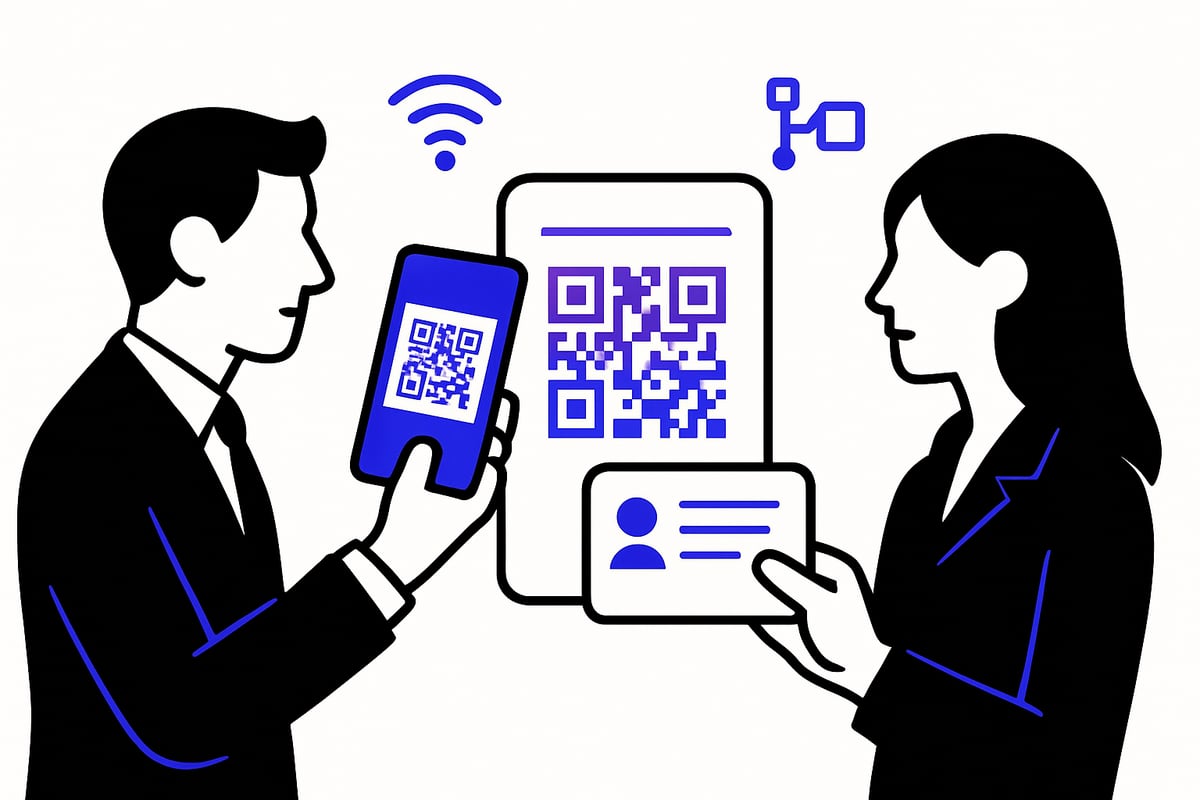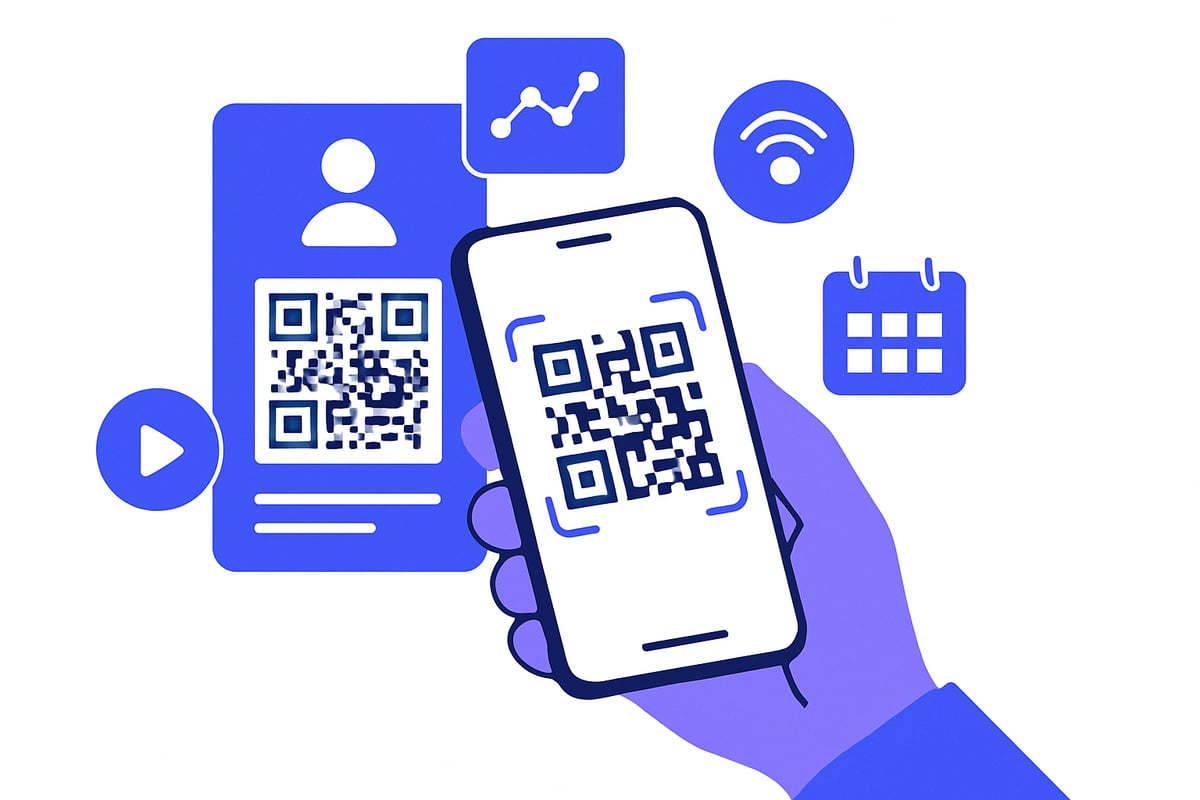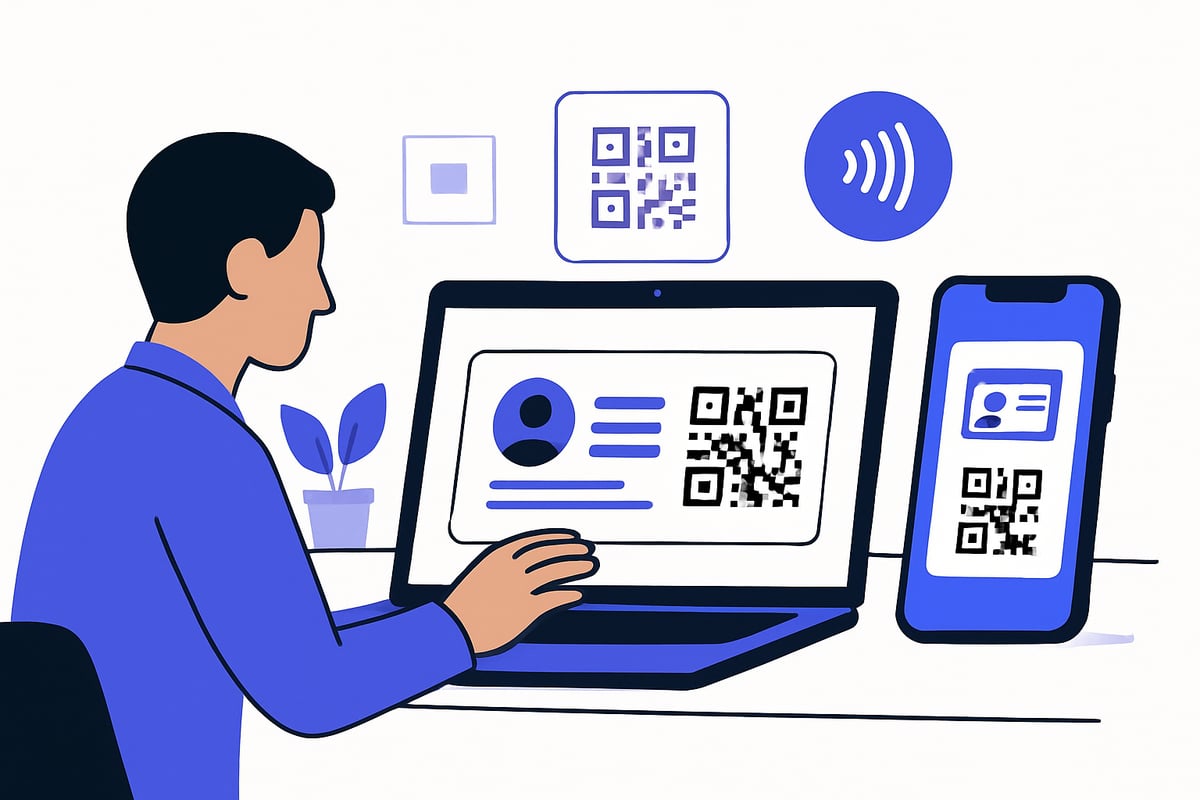Scan Code Business Cards Guide: Everything You Need to Know 2025
14 minutes
11th of October 2025
In this article:
- What Are Scan Code Business Cards?
- Key Benefits of Scan Code Business Cards
- How Scan Code Business Cards Work: Technologies & Features
- Step-by-Step Guide: Setting Up and Using a Scan Code Business Card
- Best Practices and Tips for Maximizing Impact
- The Future of Scan Code Business Cards: Trends to Watch in 2025
Imagine meeting someone at a conference and exchanging details instantly, no paper, no typing, just a quick scan. This is the new reality with scan code business cards, transforming networking for professionals and businesses in 2025.
In this guide, you will discover what scan code business cards are, how they work, and why they are quickly becoming the preferred choice for modern connections. We will explore their key benefits, the latest technology powering them, step-by-step setup, best practices, and future trends.
Whether you want to streamline your networking or make a lasting impression, this comprehensive resource will show you how scan code business cards can revolutionize your approach. Ready to upgrade your connections? Let’s dive in.
What Are Scan Code Business Cards?
Scan code business cards are modern networking tools that let you share your professional details instantly with a simple scan. In 2025, these cards use scannable codes—like QR or NFC—to connect people without the need for paper or manual data entry. Instead of handing over a physical card, you present a code that links directly to your digital profile or contact page.

Types of Codes Used in Scan Code Business Cards
The most common formats are QR codes and NFC chips. QR codes display a unique pattern that can be scanned by any smartphone camera. NFC (Near Field Communication) cards use embedded chips to transfer contact info when tapped against compatible devices. In 2025, scan code business cards often offer both options, letting users choose based on their needs.
Dynamic QR codes, which can be updated or redirected after printing, are gaining popularity. Static codes, on the other hand, point to fixed information and cannot be changed. Emerging technologies like augmented reality triggers and Bluetooth Low Energy (BLE) tags are also making their way into scan code business cards.
How Scan Code Business Cards Differ From Traditional Cards
Unlike traditional paper cards, scan code business cards are always up-to-date and eco-friendly. Users can update their contact details instantly, so recipients always access the latest information. Digital cards can also include rich media—such as video introductions, product demos, or scheduling links—that paper cards cannot provide.
The process is also more efficient. Instead of typing in details or risking lost cards, a single scan saves all information directly to a phone or contacts app. This seamless experience is driving more professionals and businesses to adopt scan code business cards.
Use Cases and Adoption Rates
Scan code business cards are widely used at networking events, conferences, trade shows, and even in virtual meetings. They are especially effective for remote introductions and online interactions, where traditional cards are not practical.
Recent digital business card adoption statistics show that about 40% of professionals used QR-based business cards in 2024, a trend expected to rise in 2025. Major companies and forward-thinking individuals have integrated scan code business cards into their daily workflows, improving follow-up rates and reducing the risk of lost opportunities.
Security, Privacy, and Misconceptions
Security and privacy are key considerations for scan code business cards. Many platforms offer features like password protection, data encryption, and permission controls to ensure data is only shared with intended recipients. Users can manage what information is accessible, revoke access at any time, and even set codes to expire after use.
A common misconception is that scan code business cards are less secure than paper ones. In reality, digital options often provide more control and traceability. Another myth is that recipients need special apps, but most smartphones can scan QR or use NFC natively.
Scan code business cards are reshaping professional networking by making connections faster, smarter, and more secure.
Key Benefits of Scan Code Business Cards
The way professionals exchange information is changing rapidly. Scan code business cards offer a seamless, modern solution that outpaces traditional paper cards in every aspect. These cards are not just a trend. They are reshaping how we connect, share, and grow our networks.

Instant, Error-Free Contact Sharing
With scan code business cards, sharing contact information becomes instantaneous. A quick scan with a smartphone camera captures details without any typing or spelling mistakes. This eliminates the frustration of manual data entry and reduces the risk of errors.
- No need to carry stacks of paper cards.
- Easily share at events, conferences, or even during virtual meetings.
- Recipients instantly receive accurate, up-to-date details.
Always Up-to-Date Information
One of the biggest advantages of scan code business cards is that your contact information is always current. Unlike traditional cards, which become outdated after a job change or phone number update, digital profiles linked to scan codes can be edited in real time.
- Update your phone number, email, or job title anytime.
- No need to reprint or redistribute physical cards.
- Ensure every new connection has your latest details.
Eco-Friendly and Cost-Effective Networking
Scan code business cards contribute to sustainability. By reducing paper waste, you help protect the environment while also saving on printing costs. Companies can distribute cards to entire teams without ongoing expenses.
- Lower environmental impact.
- No recurring printing or shipping fees.
- Easily deploy cards to new employees or departments.
Enhanced Engagement and Analytics
Digital scan code business cards go beyond basic contact sharing. They can include rich media, such as product demos, videos, and interactive lead forms. This interactivity boosts engagement and helps your connections remember you.
Businesses also gain access to analytics, tracking how often cards are viewed or shared. According to QR code usage in marketing and advertising, QR code scans surged 323 percent over two years, reflecting their growing role in business engagement strategies.
- Add links to portfolios, booking calendars, or social media.
- Capture leads directly from your card.
- Use analytics to measure networking success.
Accessibility and Improved Networking Outcomes
Scan code business cards are designed for universal access. Recipients do not need to install an app, and the cards work across different devices and platforms. This broad compatibility ensures you can connect with anyone, anywhere.
- No app or special software required.
- Works on iOS, Android, and web browsers.
- Cross-platform compatibility increases your reach.
The impact is measurable. Some providers report up to 630 percent more follow-ups and response rates compared to traditional cards. Professionals find it easier to nurture relationships and convert connections into business opportunities.
Real-World Success Stories
Leading companies and individuals have embraced scan code business cards to modernize their networking. For example, global sales teams use them to automate lead capture at events, while startups leverage them for fast, eco-friendly brand promotion.
These cards are not just a digital upgrade. They are a catalyst for smarter, more effective networking in today's professional landscape.
How Scan Code Business Cards Work: Technologies & Features
Understanding how scan code business cards operate is essential for professionals aiming to modernize their networking in 2025. The core technologies—QR codes, NFC, and advanced integrations—have transformed the way we share and manage contact information. Let’s explore the features powering this revolution.

QR Codes: The Backbone of Scan Code Cards
QR codes are the primary engine behind most scan code business cards. These two-dimensional barcodes store a wealth of contact data, including names, job titles, emails, and social links. When scanned with a phone camera, they instantly transfer details to the recipient’s device, making the process seamless.
There are two main types of QR codes used in scan code business cards: static and dynamic. Static codes are fixed—once created, their data cannot be changed. Dynamic codes, however, can be updated anytime, allowing users to modify contact information without generating a new code. This flexibility is crucial for professionals who frequently change roles or contact details.
| Feature | Static QR Code | Dynamic QR Code |
|---|---|---|
| Editable Content | No | Yes |
| Analytics | No | Yes |
| Security Options | Limited | Advanced |
| Use Case | Simple | Professional |
Customization is another key advantage. Scan code business cards can feature branded QR codes with unique colors and embedded logos, reinforcing company identity. Security is enhanced through features like expiration dates, password protection, and data encryption.
The global role of QR codes is expanding rapidly, as seen in the Global QR code payment market growth, which reflects their increasing adoption across industries, including business networking. Event organizers now use dynamic QR codes on badges, enabling attendees to connect with a scan and track engagement in real time.
NFC and Other Contactless Technologies
NFC, or Near Field Communication, adds another layer to scan code business cards. With NFC, users can transfer contact details simply by tapping their card or phone against another compatible device. This method is not only fast but also highly intuitive.
Compared to QR codes, NFC offers speed and convenience, especially in face-to-face interactions. However, QR codes remain universally accessible, since nearly all smartphones can scan them without extra hardware. Physical NFC cards are popular at trade shows and retail locations, while virtual NFC cards can be shared via mobile wallets or email signatures.
Data privacy is a core consideration for scan code business cards using NFC. Users have control over the information shared, and compatibility has broadened as more devices support contactless communication. This flexibility ensures that professionals can network confidently, regardless of the devices involved.
The choice between QR and NFC often depends on context. For example, NFC excels in high-traffic, in-person environments, while QR codes shine in both remote and hybrid settings.
Advanced Features in 2025
Scan code business cards in 2025 offer a suite of advanced features beyond basic contact sharing. Integration with Apple Wallet and Google Wallet allows users to store and access their cards effortlessly. Embedding videos, scheduling links, and interactive lead forms enhances engagement and provides richer experiences.
For businesses, CRM and HR system integrations enable automatic contact syncing, while AI-powered scanning helps organize and prioritize new connections. Sales teams benefit from automation, capturing leads instantly and reducing manual entry.
Key 2025 features include:
- Digital wallet compatibility for instant access.
- Multimedia support, such as video intros and product demos.
- Automated lead capture and CRM integration.
- AI-driven analytics for smarter follow-ups.
These innovations make scan code business cards indispensable tools for modern professionals. As technology evolves, expect even more personalized and secure networking experiences.
Step-by-Step Guide: Setting Up and Using a Scan Code Business Card
Setting up scan code business cards is simple, but doing it right ensures you maximize their impact. Follow this clear, step-by-step guide to create a card that is professional, effective, and ready for networking in 2025.

Step 1: Choose the Right Platform or Provider
The first step in creating scan code business cards is selecting a platform that matches your needs. Consider customization options, integration with CRM systems, data privacy compliance, and customer support.
Evaluate whether you need advanced features like analytics, team management, or HR integrations. Many providers offer both free and paid versions, with paid plans often unlocking branding and automation tools. Compare popular platforms using a table to clarify your options.
| Provider | Custom Branding | CRM Integration | Free Plan | Support Level |
|---|---|---|---|---|
| Provider A | Yes | Yes | Yes | 24/7 |
| Provider B | Limited | No | Yes | Email only |
| Provider C | Yes | Yes | No | Phone/Email |
Choose a provider that allows you to easily manage scan code business cards for yourself or your entire team.
Step 2: Design and Customize Your Digital Card
Next, focus on designing scan code business cards that reflect your brand identity. Upload your company logo, choose brand colors, and select a professional layout. Most platforms provide templates for quick setup.
Enhance your card by adding multimedia elements such as a profile photo, introductory video, or product demo. For teams, ensure all cards are consistent in design, messaging, and content. This step helps your scan code business cards stand out and make a memorable first impression.
Test different designs with colleagues to ensure clarity and appeal. Remember, a well-designed card increases engagement and trust.
Step 3: Generate and Link Your Scan Code
Once your digital card is ready, it is time to generate a unique scan code. Most platforms let you create either a QR code or an NFC tag linked to your digital profile or a custom landing page.
When generating scan code business cards, ensure the code is high resolution so it scans easily across devices. Place the code in a prominent spot on your card design, and consider adding your logo inside the code for extra branding.
Follow best practices: avoid clutter around the code, use contrasting colors for visibility, and test the scan on multiple devices before sharing.
Step 4: Share Your Scan Code Card Effectively
Sharing scan code business cards is all about accessibility and reach. Print your QR code on physical cards, use it in your digital signature, or display it as a virtual background during video calls.
Many platforms support adding your card to Apple Wallet or Google Wallet for instant access. At events, display your scan code on your badge or booth for easy connections. Online, share your card link via email or social media.
Your scan code business cards should not require recipients to install an app, making networking seamless for everyone.
Step 5: Capture Leads and Track Engagement
To fully leverage scan code business cards, enable lead capture forms and calendar scheduling links on your digital card. This allows contacts to book meetings or submit information instantly.
Integrate with your CRM to automatically sync new contacts and segment them for follow-up. Most platforms provide analytics, showing views, scans, and engagement rates.
By reviewing these insights, you can measure the effectiveness of your scan code business cards and refine your networking strategy for better results.
Step 6: Update and Manage Your Card Over Time
One of the biggest advantages of scan code business cards is real-time updating. Edit your details, add new links, or change your photo without reprinting anything.
Manage multiple cards for different roles, events, or teams from one dashboard. If needed, revoke or update codes to maintain security and control access.
Staying proactive with updates ensures your scan code business cards always reflect your latest information and branding, keeping your professional connections strong.
Best Practices and Tips for Maximizing Impact
Implementing scan code business cards effectively requires more than just generating a QR code. To maximize results, professionals and teams should focus on strong design, robust security, user accessibility, and consistent usage. The following best practices will help you unlock the full potential of scan code business cards in any professional setting.
Design and Branding
A well-designed scan code business card is clear, visually appealing, and on-brand. Use high-contrast colors and readable fonts to ensure easy scanning in different lighting conditions. Incorporate your logo and brand colors while keeping the layout uncluttered.
- Place your scan code in a prominent, scannable location.
- Include a compelling call-to-action, such as “Scan to connect.”
- Test your design on multiple devices before deployment.
Consistency across all scan code business cards within your organization reinforces your brand image. For teams, provide templates to maintain a unified look and feel.
Security, Privacy, and Compliance
Protecting user data is essential when using scan code business cards. Choose a provider that offers encryption, password protection, and the ability to revoke or update codes instantly. Always inform recipients about what data will be shared and how it will be used.
For organizations operating in regulated environments, ensure your solution is compliant with GDPR and other relevant privacy laws. Limit access to sensitive information and regularly review permissions settings.
Team Training and Consistency
Introduce scan code business cards with proper training. Provide team members with clear instructions on how to use, share, and update their cards. Encourage staff to practice scanning and sharing in different contexts, including virtual and in-person events.
- Develop internal guidelines for card updates and branding.
- Assign a point person to manage questions or troubleshooting.
- Regularly review usage to ensure compliance and consistency.
Troubleshooting and Accessibility
Anticipate and address common issues with scan code business cards. If a code fails to scan, check for print quality, contrast, and size. Offer alternative sharing methods, such as digital links or NFC, for users with accessibility needs.
Ensure your cards are usable by everyone, including those with visual or motor impairments. Use descriptive labels and provide accessible digital profiles. Many industries leverage QR codes for various tasks, from marketing to logistics, as shown in QR codes in supply chain and inventory management, highlighting the importance of reliability and versatility.
Metrics and Continuous Improvement
Track the performance of your scan code business cards using built-in analytics. Monitor views, scans, and follow-ups to assess what works best. Set measurable goals for engagement rates and lead capture.
- Review analytics regularly for actionable insights.
- A/B test different designs or calls to action.
- Use feedback from recipients to refine your approach.
By applying these best practices, you ensure your scan code business cards deliver professional impact, foster meaningful connections, and support ongoing business growth.
The Future of Scan Code Business Cards: Trends to Watch in 2025
Imagine a world where your networking tools anticipate your needs, adapt to new technologies, and keep you ahead of the curve. As we look toward 2025, scan code business cards are evolving rapidly, promising professionals even more powerful ways to connect and engage.
AI and Automation:
Artificial intelligence is transforming scan code business cards. Expect smarter contact management, with AI-driven suggestions for follow-ups and predictive networking. Automated syncing with CRM platforms will boost efficiency, making every scan more valuable for both individuals and organizations.
Immersive Experiences with AR and VR:
Soon, scan code business cards will bridge the digital and physical worlds. Augmented and virtual reality integrations will allow users to showcase 3D portfolios or host virtual meetings instantly via a simple scan, enhancing first impressions and engagement.
Expansion of NFC and Contactless Tech:
NFC technology is set to become even more accessible and reliable. Physical cards and smartphones will exchange information quickly, supporting seamless networking at events of any size. As adoption grows, compatibility across devices and platforms will improve, making scan code business cards even more universal.
Personalization at Scale:
Dynamic content is the next frontier. Scan code business cards will deliver personalized experiences, adjusting contact details, video intros, or downloadable resources based on the recipient or event context. This level of customization will set new standards for professional introductions.
Enhanced Security and Verification:
Security is a top priority for scan code business cards. Expect biometric authentication, such as fingerprint or facial recognition, to protect sensitive information. Blockchain verification will add another layer of trust, ensuring data integrity and user control.
| Security Feature | Benefit |
|---|---|
| Biometric Authentication | Strong user validation |
| Blockchain Verification | Tamper-proof data, transparency |
Regulatory and Compliance Advances:
As privacy regulations evolve, scan code business cards will adapt to meet global standards like GDPR and CCPA. Providers will prioritize transparency, user consent, and data minimization, ensuring professionals remain compliant in every market.
Sustainability and Paperless Networking:
The environmental impact of networking is under scrutiny. Scan code business cards will continue replacing paper cards, reducing waste and supporting corporate sustainability goals. Digital-first solutions align with eco-conscious business practices and modern expectations.
What’s Next?
Over the next five years, scan code business cards will become smarter, greener, and more secure. With continuous innovation, these tools will empower professionals to forge stronger connections, stay compliant, and make networking effortless.
Now that you understand how scan code business cards are transforming the way we connect and network, why not experience the benefits firsthand? Imagine having a customizable, always up-to-date card that you can share instantly—no printing or app required. With Spreadly, you get seamless integration, advanced lead capture, and smart analytics, all designed to help you make memorable connections and streamline follow-ups. Whether you are representing yourself or managing a team, it is easy to get started and see real results. Ready to simplify your networking? Try for free.






